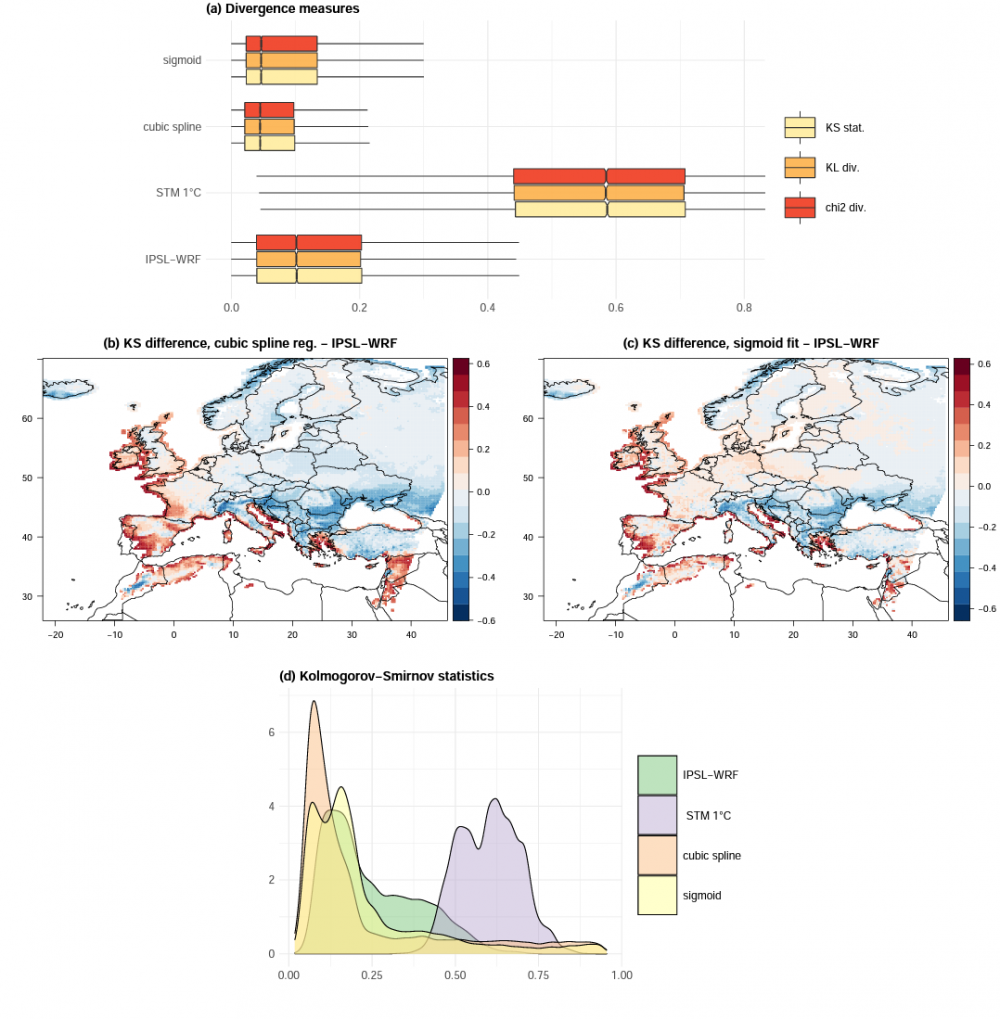
These panels show the improvement of snowfall representation in the IPSL-WRF RCM over Europe using different statistical models. Panel (a) shows boxplots of three statistical divergences among snowfall distributions, with lowest values provided by the spline regressions. Central panels compare the differences respect to unadjusted IPSL-WRF in the Kolmogorov-Smirnov statistics for spline regression (b) and sigmoid fit (c). Details of the distributions of the Kolmogorov-Smirnov statistics are shown in panel (d).
The description and analysis of compound extremes affecting mid and high latitudes in the winter requires an accurate estimation of snowfall. This variable is often missing from in-situ observations, and biased in climate model outputs, both in magnitude and number of events; moreover, large discrepancies in snowfall amounts exist between observational and reanalysis datasets, depending on the region [1]. While climate models can be adjusted using bias correction (BC), snowfall presents additional challenges compared to other variables, preventing one from applying traditional univariate BC methods. We extend the existing literature on the estimation of the snowfall fraction from near-surface temperature, which usually involves binary thresholds [2] or fitting parametric nonlinear functions [3]. We show that, considering models such as segmented and spline regressions and nonlinear least squares fitting, it is possible to obtain accurate out-of-sample estimates of snowfall over Europe in ERA5 reanalysis, and to perform effective BC on the IPSL-WRF high resolution EURO-CORDEX climate model only relying on bias adjusted temperature and precipitation. This method offers a feasible way to reconstruct or adjust snowfall observations without requiring multivariate or conditional bias correction and stochastic generation of unobserved events. This work is currently under review for the interdisciplinary journal Advances in Statistical Climatology, Meteorology and Oceanography and the article is available [4] and it has been supported by the ANR-TERC project BOREAS.
[1] Faranda, D.: An attempt to explain recent changes in European snowfall extremes, Weather and Climate Dynamics, 1, 445–458, 2020. [2] Schmucki, E., Marty, C., Fierz, C., and Lehning, M.: Simulations of 21st century snow response to climate change in Switzerland from a setof RCMs, International journal of climatology, 35, 3262–3273, 2015 [3] Dai, A.: Temperature and pressure dependence of the rain-snow phase transition over land and ocean, Geophysical Research Letters, 35,6652008 [4] Pons, F. M. E. and Faranda, D.: Statistical reconstruction of European winter snowfall in reanalysis and climate models based on air temperature and total precipitation, Adv. Stat. Clim. Meteorol. Oceanogr., 8, 155–186, https://doi.org/10.5194/ascmo-8-155-2022, 2022.






